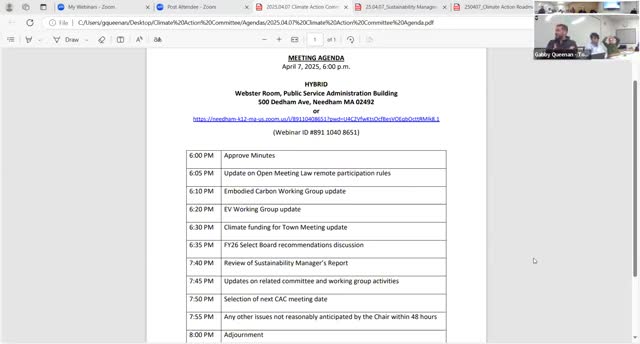EV working group to profile apartment and commercial sites after mixed vendor experiences
April 08, 2025 | Town of Needham, Norfolk County, Massachusetts
This article was created by AI summarizing key points discussed. AI makes mistakes, so for full details and context, please refer to the video of the full meeting. Please report any errors so we can fix them. Report an error »

The Town of Needham Climate Action Planning Committee’s EV working group reported on April 7 that it will begin profiling apartment buildings and select commercial sites to document procurement models, charger pricing and usage.
Ajay, an EV working group member, said outreach to several large apartment complexes (Modera, Charles River Landing and Vander) produced few responses: “I sent emails to each of them, and I got 0 responses.” He said the group plans follow‑up visits and in‑person requests to secure meetings and produce an initial profile of at least one building’s procurement, vendor choice and usage data.
Committee members discussed recent local charger installations and vendor arrangements. Paul said he spoke with the manager of the Whole Foods in Wellesley and described a vendor change there: the store replaced ChargePoint units with Shell equipment. Paul said the Whole Foods manager told him Shell operates and collects revenue from the stations and Whole Foods does not receive a share; as a result, Paul said, “they used to be free. Now they’re no longer free, and the pricing is more expensive.” Committee members raised concerns that high per‑session fees and per‑use transaction charges could reduce utilization.
The group discussed candidate locations for charging infrastructure and business models that encourage long‑dwell charging (office parking, employee charging) versus short‑dwell retail locations. Members identified multifamily housing and office campuses as high‑priority locations because residents and employees park for longer periods. Suggestions for candidate sites included TripAdvisor, Coca‑Cola facilities, Staples, YMCA locations and private corporate lots where lot owners could control access.
Committee members noted existing incentives and costs. A working‑group participant said Level‑2 installations are substantially cheaper than Level‑3 and that major cost drivers include trenching distance and the need for additional transformers or utility upgrades. The transcript discussion included a rough illustrative cost contrast offered by a participant: multifamily projects can run into tens of thousands to millions depending on complexity; by contrast, a simple Level‑2 installation may be in the low thousands when utility capacity is adequate.
Paul shared a planning idea: when a parking lot is redeveloped, require underground conduits or other “future‑proofing” so charging infrastructure can be added later at lower marginal cost. The group also discussed available rebates for multifamily charger installations and noted a regional MAPC pilot on bidirectional charging that could inform future work.
Next steps: the EV working group will try to secure at least one detailed building case study (procurement, vendor, usage) to use as a model for broader recommendations on procurement, siting and potential town encouragement measures.
Ajay, an EV working group member, said outreach to several large apartment complexes (Modera, Charles River Landing and Vander) produced few responses: “I sent emails to each of them, and I got 0 responses.” He said the group plans follow‑up visits and in‑person requests to secure meetings and produce an initial profile of at least one building’s procurement, vendor choice and usage data.
Committee members discussed recent local charger installations and vendor arrangements. Paul said he spoke with the manager of the Whole Foods in Wellesley and described a vendor change there: the store replaced ChargePoint units with Shell equipment. Paul said the Whole Foods manager told him Shell operates and collects revenue from the stations and Whole Foods does not receive a share; as a result, Paul said, “they used to be free. Now they’re no longer free, and the pricing is more expensive.” Committee members raised concerns that high per‑session fees and per‑use transaction charges could reduce utilization.
The group discussed candidate locations for charging infrastructure and business models that encourage long‑dwell charging (office parking, employee charging) versus short‑dwell retail locations. Members identified multifamily housing and office campuses as high‑priority locations because residents and employees park for longer periods. Suggestions for candidate sites included TripAdvisor, Coca‑Cola facilities, Staples, YMCA locations and private corporate lots where lot owners could control access.
Committee members noted existing incentives and costs. A working‑group participant said Level‑2 installations are substantially cheaper than Level‑3 and that major cost drivers include trenching distance and the need for additional transformers or utility upgrades. The transcript discussion included a rough illustrative cost contrast offered by a participant: multifamily projects can run into tens of thousands to millions depending on complexity; by contrast, a simple Level‑2 installation may be in the low thousands when utility capacity is adequate.
Paul shared a planning idea: when a parking lot is redeveloped, require underground conduits or other “future‑proofing” so charging infrastructure can be added later at lower marginal cost. The group also discussed available rebates for multifamily charger installations and noted a regional MAPC pilot on bidirectional charging that could inform future work.
Next steps: the EV working group will try to secure at least one detailed building case study (procurement, vendor, usage) to use as a model for broader recommendations on procurement, siting and potential town encouragement measures.
View full meeting
This article is based on a recent meeting—watch the full video and explore the complete transcript for deeper insights into the discussion.
View full meeting
